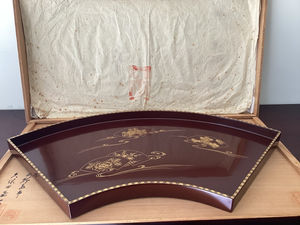Create Your First Project
Start adding your projects to your portfolio. Click on "Manage Projects" to get started
Antique Japanese Lacquer Fan Tray Meiji 36 (1903)
Antique Japanese Lacquer Fan Tray
Meiji 36 (1903)
* please ignore light reflections
Antique Wajima Lacquer Fan Tray that dates to 1903.
This tray was a prize winning exhibit in the 36th year of Meiji Period.
A rare superb plum coloured lacquered fan shaped tray decorated with four fan shape panels, Pine, Peony, Plum, Chrysanthemum.
The rim finely incised, gold inlaid.
This superb form of lacquer workmanship is known as Chinkin, 沈金 , meaning sinking gold.
Chinkin is a very specialised Japanese Lacquer Art technique that involves carving and engraving decorative designs on a lacquer surface.
It is believed that the Chinkin technique of decorating Japanese lacquer ware originated in China during the Sung dynasty (960 to 1279).
Once the design is engraved onto a lacquer surface, it is sprinkled with gold, silver or other precious metal powders.
Refer Large Images for details, quality and condition, they also form the description.
Depending on your computer monitor / phone / etc colour may vary to actual.
Excellent condition, a stored family treasure for over 100 years.
Original Tomobako - Wood Box characters read: Sen kei bon (Fan shape tray). Sen men chin kin tsuku (ZFan faced with chinkin lacquer) . Ichi (1)
Ku bo ta (artist surname) ka ichi (first name ) sei (made)
The original washi paper bag for the tray, heavily aged stained (122 years old) with red seal stamps.
Translations – refer images.
Length about : 60 cm
Width about : 27.5 cm
Height about: 3.2 cm
Weight about: 665 grams
A$550
In Japan
Pine trees symbolise endurance and longevity.
Peony symbolise bravery, honour and good fortune.
Plum symbolise good fortune, an auspicious flower, along with pine and bamboo, and the arrival of early spring.
Chrysanthemum symbolise longevity and good fortune
The finest quality wood lacquer in the world is that made in Japan.
Made using only the best woods such as, Zelkova (keyaki), Japanese Chestnut, Japanese Cypress, Magnolia, Cherry.
It takes approximately 6 months and 23 different processes from start to finish to produce each individual Handmade Item
Wajima Lacquer:
It is said that the current Wajima-nuri technique was established during the Kanbun era in the early Edo period.







































